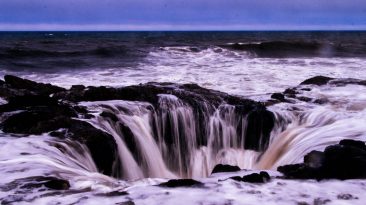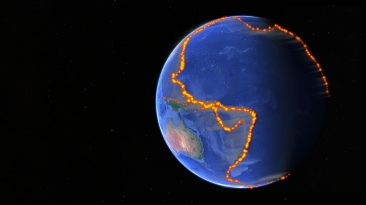You might have heard that all dinosaurs were wiped out 65 million years ago when a 15 km wide asteroid crashed into Earth and caused a mass extinction event. But that – is entirely false. One species of dinosaur, theropods, managed to survive. They had feathers and hollow bones, and most of them could fly, meaning they could rise above the blast and survive the aftermath. And now, many scientists believe that these theropod dinosaurs managed to evolve into birds. So technically, dinosaurs are still alive and with us today.
But that’s not the only thing you were lied to about dinosaurs. From non-existent species to T-Rex’s eyesight, there are many myths and misconceptions about the Mesozoic era.
One of the craziest is that dinosaurs were all green, scaly monsters.In fact, many of them likely had feathers. Theropods would have had feathers for a variety of reasons, from giving them warmth to helping some aviation-based dinos to fly. And that’s not all. Dinosaurs were also a variety of colors. Some fossils have preserved pigments, showing that not all dinosaurs were brown, black or green. They may have had many more vibrant colors.
Some of them may have even had specific camouflage, depending on their environment. And they weren’t all scaly and slimy either. Different dino species would have different textures and appearances on their skin. I wonder if any of them were fluffy?
When you think of dinosaurs, you probably think they were all massive. The T-Rex had a length of up to 12 meters (40ft), and the long-necked Brachiosaurus was up to 13 meters (43ft) tall. But that wasn’t the case for all dinosaurs. Contrary to popular belief, not all dinos were giants. In fact, many of them were pretty small. Some were even the size of birds that we have today! Aww, cute. One small dinosaur was the Microraptor. This little guy was about the size of a crow. He even had wings and feathers, making him look like a bird.
Dinos are typically portrayed as slow-moving, cold-blooded reptiles. But this isn’t totally accurate. Scientists have recently discovered that dinosaurs weren’t all cold-blooded like we thought. But that doesn’t mean they were all warm-blooded. It’s a bit more complicated. Dinosaurs may have had a metabolic system known as mesothermic.
This means they were somewhere between cold and warm-blooded. Being mesothermic allows animals to generate some internal heat, just not as much as a warm-blooded animal would. Dinosaurs with feathers may have been warm-blooded. Feathers usually suggest ‘warm-blooded.’ Now of course, there were thousands of species of dinosaurs, so sure, many may have been cold-blooded, but there were also warm-blooded and mesothermic dinosaurs.
The Brontosaurus is one of the most iconic dinosaurs ever. With its long neck and tail, it’s probably one of the first dinosaurs you think of. But did you know that these creatures almost didn’t exist? In the 19th century, the Brontosaurus was accidentally classified as the Apatosaurus, a species with similar traits.
It wasn’t until 2015, after years of research, that the Brontosaurus was reclassified as its own dinosaur. Kind of like how Pluto comes and goes as a planet, the dinosaur community seems to have some trouble making up their mind on the validity of the name Brontosaurus.
Movies like Jurassic Park often show the Tyrannosaurus Rex as one of the most deadly predators, destroying everything in its path. The only catch? They can only see prey if it moves. That’s also completely false. To make the T-rex even more terrifying, they had incredible vision and were able to easily see prey that stood still.
Since the T-Rex’s eyes were positioned forward on its head, it had binocular vision. It could easily judge distances and see objects in three dimensions, similar to how humans see. Research suggests that the T-Rex might have had better eyesight than modern-day birds because it had such large optic nerves.
It’s easy to forget, but dinosaurs didn’t all live simultaneously. The Mesozoic Era, also known as the age of dinosaurs, spanned over 180 million years. There were three distinct periods – Triassic, Jurassic, and Cretaceous. And within these periods, different species were unique to the specific era. Within 180 million years, some dinosaurs evolved into new forms, and some species even went extinct. Some of the most iconic dinosaurs, like the Stegosaurus and T-Rex, never actually coexisted. They lived in entirely different time periods, tens of millions of years apart.
Also, the T-Rex is often shown as a Godzilla-like creature that can stand upright. But how accurate is this? Turns out it’s a total misconception based on early artists’ renderings. Paleontologists have since found that the T-Rex had a more horizontal posture. Its tail was held up off the ground, and its body was balanced over the hips. The upright stance of the T-rex that we typically see is fun for Hollywood, but it would be unstable and impractical for the dinosaur to move around freely.
When fossils are dug up, the shrink-wrap method has been used to portray the dinosaurs. This is where the skin and features are drawn tightly around the skeleton. The technique has led to some iconic dinosaur portrayals but is incredibly inaccurate when it comes to how these dinos actually looked. The problem is that it doesn’t account for any muscles, fat, or other soft tissues that the dinosaurs had. Luckily this method is considered outdated.
Paleontologists now account for muscles and fat that the dinosaurs were likely packing on. They make comparisons with modern animals to find where muscle would typically be attached to the bone. This has led to a more realistic appearance for the dinosaurs.
Paleontologists have identified over 1,000 different species of dinosaurs, but there are tons more left to discover, literally. The numbers vary, but some research suggests we’ve only found about 30% of dinosaur species. And some we may never find due to gaps in the fossil record. Depending on where a species lived, they may have never been fossilized due to their environment. But many more will be discovered. On average, paleontologists discover about 50 new dinosaur species every year.
Dinosaurs probably don’t sound anything like this. In fact, we really have no idea what they sound like. Fossilization rarely preserves the soft tissues, like vocal cords. This makes it challenging for paleontologists to determine the exact sounds dinosaurs made. But it is unlikely that they made these massive roars.
Scientists can make an educated guess that dinos sounded closer to birds and crocodiles since they’re the closest living relatives of dinosaurs. Researchers have created models based on fossilized skulls. The models suggest that the dinosaurs may have made low-frequency rumbles or bird-like calls. Regardless of what they sounded like exactly, the scientific community agrees that they didn’t sound like this.
So, is it possible that one day, we’ll be able to clone dinosaur DNA and build our very own Jurassic Park? Well, as cool as that may be, it’s never going to happen. Since DNA degrades over time, the chance of finding intact dino DNA is basically zero. And even if some were found, extracting the DNA without any contamination or deterioration would be incredibly difficult. Now, what if the DNA was preserved in amber? Similar to the movie?
Well, that’s also highly unlikely since the DNA can’t survive for tens of millions of years inside of amber.
You know, the Mesozoic Period was an incredible time in Earth’s history and one that we’re learning more about every day. But what happened immediately after this period ended? When the dinosaurs went extinct?



























